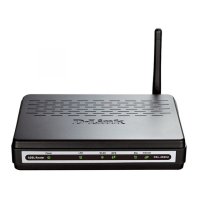Web Configuration
D-Link DSL-2600U User Manual
61
signals. WLAN devices generate a carrier wave and modulate this signal using various techniques. Digital data is superimposed onto the carrier signal. This radio signal
carries data to WLAN devices within range of the transmitting device. The antennae of WLAN devices listen for and receive the signal. The signal is demodulated and the
transmitted data extracted. The transmission method used by the access point is called Direct Sequence Spread Spectrum (DSSS) and operates in a range of the radio
spectrum between 2.4GHz and 2.5GHz for transmission. See the expert technical specifications for more details on wireless operation.
Antennas
Direct the external antenna to allow optimization of the wireless link. If for example the antenna is erect, wireless links in the horizontal plane are favored. Please note that
the antenna characteristics are influenced by the environment, that is, by reflections of the radio signal against walls or ceilings. It is advisable to use the received signal
strength as indicated by the wireless client manager to optimize the antenna position for the link to a given client. Concrete walls weaken the radio signal and thus affect
the connection.
Range
Range should not be a problem in most homes or small offices. If you experience low or no signal strength in some areas, consider positioning the Router in a location
between the WLAN devices that maintains a roughly equal straight-line distance to all devices that need to access the Router through the wireless interface. Adding more
802.11g access points to rooms where the signal is weak can improve signal strength. Read the section about placement of the Router titled Location in the next chapter,
Hardware Installation, for more information.
SSID
Wireless networks use an SSID (Service Set Identifier) to allow wireless devices to roam within the range of the network. Wireless devices that wish to communicate with
each other must use the same SSID. Several access points can be set up using the same SSID so that wireless stations can move from one location to another without
losing connection to the wireless network. The Modem operates in Infrastructure mode. It controls network access on the wireless interface in its broadcast area. It will
allow access to the wireless network to devices using the correct SSID after a negotiation process takes place. By default the Modem broadcasts its SSID so that any
wireless station in range can learn the SSID and ask permission to associate with it. Many wireless adapters are able to survey or scan the wireless environment for
access points. An access point in Infrastructure mode allows wireless devices to survey that network and select an access point with which to associate. You may disable
SSID broadcasting the wireless menu of web management.
Radio channels
The 802.11g standard allows several WLAN networks using different radio channels to be co-located. The Modem supports multiple radio channels and is able to select
the best radio channel at each startup. You can choose to set the channels automatically or manually.
The different channels overlap. To avoid interference with another access point, make sure that the separation (in terms of frequency) is as high as possible. It is
recommended to keep at least 3 channels between 2 different access points.
The Modem supports all channels allowed for wireless networking. However, depending on local regulations, the number of channels actually allowed to be used may be
additionally restricted, as shown in the table below.
Regulatory Domain Allowed Radio Channels
China 1 to 13
Europe 1 to 13
Israel 5 to 8
Japan 1 to 14
Jordan 10 to 13
Thailand 1 to 14
USA / Canada 1 to 11

